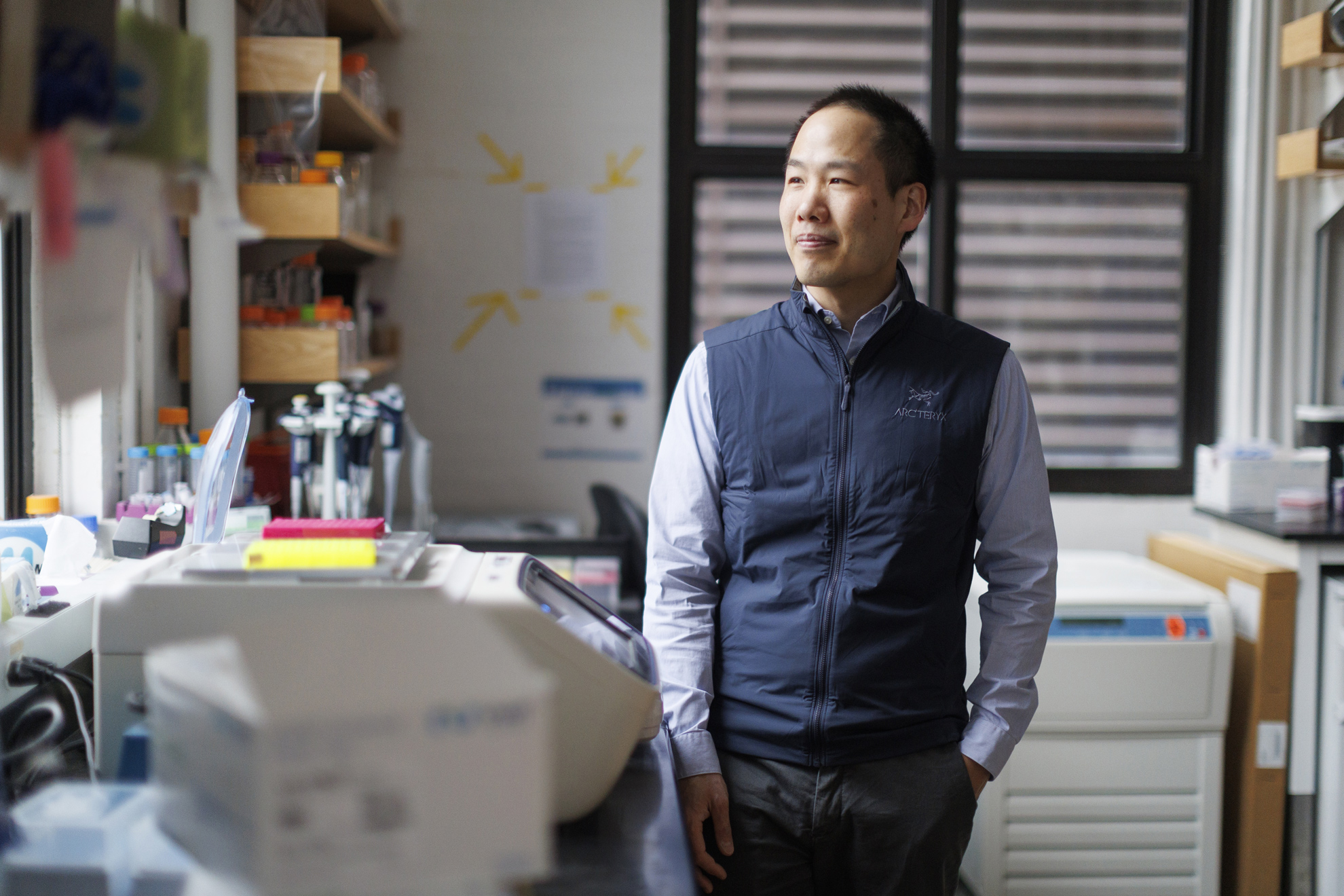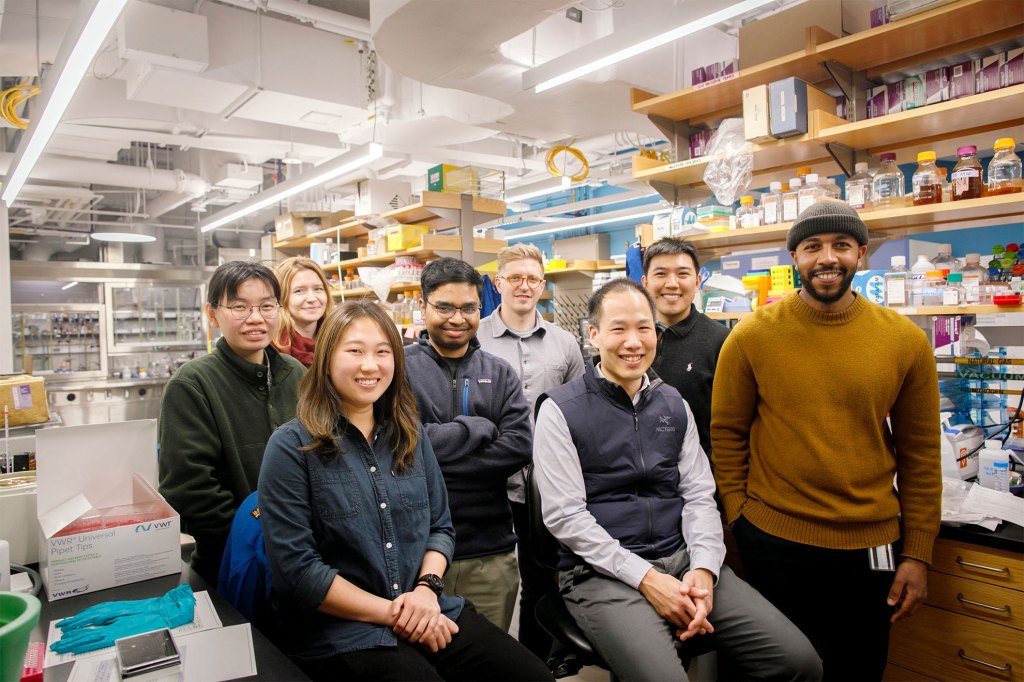Big step toward targeted molecular therapies for cancer

Brian Liau.
Photos by Stephanie Mitchell/Harvard Staff Photographer
Researchers develop innovative approaches to understand, target, disrupt uncontrollable growth of disease
Two new studies represent a big step toward developing innovative molecular therapies capable of disrupting the uncontrollable growth of cancers at their roots.
In a pair of papers recently published in Nature, a team of scientists led by Harvard’s Department of Chemistry and Chemical Biology (CCB) has demonstrated how both small molecules and genetic mutations can alter the same critical protein interactions in cancer cells. These studies provide insights into two areas: discovering new “molecular glues” and understanding the impact of genetic mutations within cancer cells, setting the stage for therapeutic approaches.
“Our research has centered on understanding how specific mutations in medulloblastoma, a pediatric brain cancer, mimic the action of ‘molecular glues’ to drive oncogenic processes,” said senior author Brian Liau, associate professor of chemistry and chemical biology. “During the course of these studies, we’ve detailed the convergence of genetic mutations and chemical modalities that alter protein interactions.”
Molecular glues are small molecules that force two proteins that normally wouldn’t interact to bind. That triggers a cell’s natural “garbage disposal system” to degrade one of the proteins. Researchers have been exploring the possibility of using molecular glues to target disease-causing proteins.
Until now, many of these interactions went unexploited because of their complexity and difficulty to find. This research, however, unveils a new scaffold and mechanism that can be used to design molecular glues to influence specific protein interactions and functions.
This work was led by members of Liau’s lab, including co-authors Megan Yeo, Olivia Zhang, Ceejay Lee, Idris Barakat, and Nicholas Chen (all Ph.D. students in the Griffin Graduate School of Arts and Sciences in CCB); postdocs Jiaming Lee, Pallavi Gosavi, Hui Si Kwok, Stefan Harry, and Amanda Waterbury, and research assistant Irtiza Iram. Additional contributions were provided by scientists at Harvard Medical School as well as the Broad Institute, the University of Washington, and St. Jude Children’s Research Hospital.

One study explored how molecular glues alter essential protein interaction networks. The researchers showed that the molecule UM171 works as a glue that can trigger the breakdown of the CoREST complex, an organizing system that controls access to genes. UM171 works by engaging with a protein called histone deacetylase (HDAC), which is part of a larger complex with CoREST, and gluing it to another protein named KBTBD4, which is an effector enzyme of protein degradation. These findings demonstrate new ways for glues to be used to target proteins traditionally considered undruggable, like CoREST, providing new strategies for drug design.
“How this small molecule works was a big question in the field because at the time no one knew for sure that it was a molecular glue,” said Zhang. “We came at this problem with a multidisciplinary approach, leveraging both functional genomics and structural biology to give us new insights.”
In the companion study, the researchers investigated cancer-causing mutations in the KBTBD4 protein, often mutated in a type of brain cancer. These mutations can turn normal cell interactions into harmful ones by changing how proteins connect, causing aberrant degradation of the CoREST complex.
The team was able to identify which mutations in KBTBD4 contribute to cancer. They then used cryo-electron microscopy (cryo-EM) to “see” these mutations at the atomic level. Combining these techniques, the team discovered that cancer mutations alter protein structure and function, mirroring the interaction of UM171 and KBTBD4.
“It’s very hard to imagine what these insertion mutations actually do without a structure since they occur in a flexible region of the protein, so having the cryo-EM structure was very helpful,” Yeo said. “It was stunning to see the direct overlay of the small molecule and these cancer mutations, which we could not have imagined without this technology.”
A defining feature of this research was its focus on “convergence,” where a small molecule and a genetic mutation precisely mimic the effects of one another functionally and structurally.
In Liau’s lab, the researchers explored how understanding one mechanism can inform the development and application of the other.
“It’s really hard to find these types of molecular glue molecules, so if you could actually use genetics to look for them, it would be very helpful,” Liau said. “This chemical genetic convergence is a new paradigm.”
Going forward, Liau’s lab plans to further explore these molecular strategies, searching for more instances of genetic mutations that can induce new protein interactions to aid chemical design. The implications of this research offer a new strategy toward understanding and targeting proteins for small molecule drug discovery.
“I’m excited about the potential directions our research can take,” Liau said. “The implications extend beyond cancer, possibly reshaping our approach to studying a variety of diseases.”
The research described in this story received funding from the National Institute of General Medical Sciences and the National Cancer Institute.





